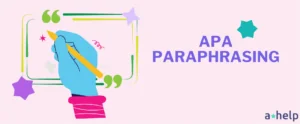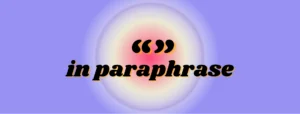Paraphrasing information is giving a makeover to someone else’s ideas using your own words. It’s a skill needed not just in academic writing, but also in research, content creation, as well literature and film reviews. In this article, we will be explaining when and why you should choose to paraphrase over quoting or summarizing. We’ll also share some tips on how to do it effectively and wrap up with some thoughts on why mastering this skill is so important.

✅ AI Essay Writer ✅ AI Detector ✅ Plagchecker ✅ Paraphraser
✅ Summarizer ✅ Citation Generator
General Usage of Paraphrasing
Paraphrasing is like a slow cooker — you can use it almost for everything. In academic writing, paraphrasing is needed when you want to show that you really understand what you’ve read or in case you need to present evidence for your claims. In any case, it allows you to incorporate the original author’s ideas into your work while keeping your own unique voice and style. If you paraphrased sonething properly, your professors will see that you’ve grasped the material and can express it in your own words.
Paraphrasing also helps you avoid the big no-no of plagiarism. It lets you take existing content and give it a fresh spin, while still keeping the same message. And it’s not just for writing essays or articles—paraphrasing is also handy in everyday conversations. Ever had to explain a complicated concept to a friend in simpler terms? That’s paraphrasing in action.
When to Quote, Paraphrase, or Summarize
Suppose you are writing a paper and need to decide whether to quote, paraphrase, or summarize. Here, the context and purpose of your writing play an important role. Each method serves a specific function in conveying information from the original source to your work.
Quoting
Quoting means reproducing an exact statement from the source material, including the original language and phrasing. This method is most effective when the original source’s words carry a significant weight of eloquence, authority, or historical importance that would be diminished if reworded. For example, quoting Martin Luther King Jr.’s “I have a dream” speech in an essay on civil rights preserves the powerful impact of his words.
In academic writing, directly quoting a well-known scientist’s unique definition or theory further adds credibility to your argument. When quoting, you have to use the exact words from the source and properly cite it to give credit to the original author.
Original Source from Martin Luther King Jr.’s Speech: “I have a dream that my four little children will one day live in a nation where they will not be judged by the color of their skin but by the content of their character.”
🗣️Quoted Text in an Essay on Civil Rights: As Martin Luther King Jr. eloquently stated in his iconic “I Have a Dream” speech, “I have a dream that my four little children will one day live in a nation where they will not be judged by the color of their skin but by the content of their character.”
Paraphrasing
Wondering, how to paraphrase correctly? Paraphrasing involves rewording the original source’s information in your own words while retaining the main points and overall message. This approach is particularly useful when you want to clarify or tailor the source material to fit the tone and style of your writing. For instance, if you are crafting a paper on climate change and come across a complex scientific study, you might paraphrase the study’s findings to make them more accessible to your readers.


Summarizing
Summarizing is the process of distilling the source material down to its most essential points, often significantly reducing its length. This method is valuable when you need to give your readers a broad overview of a large work or complex idea without goint into all the details. For example, a summary of a novel in a book review provides readers with an understanding of the plot and themes without recounting every event. In academic contexts, summarizing the key arguments of a lengthy philosophical text can help you briefly compare those ideas without loosing the accuracy.
Summaries capture the core essence of the source material and are typically much shorter than the original, making them ideal for integrating broad concepts into your work without overwhelming the reader with information.
Original Text from a Lengthy Philosophical Text: “In his treatise on human nature, the philosopher explores the intricacies of human consciousness, the nature of free will, and the interplay between individual perception and objective reality. He delves into the concepts of personal identity, examining how it is formed through experiences and memory. The philosopher also discusses the ethical implications of human actions, arguing that moral decisions are grounded in social constructs and cultural norms.”
📝Summarized Text for Academic Use: “The philosopher’s treatise examines key aspects of human nature, including consciousness, free will, and the formation of personal identity through experiences. He also explores the ethical dimensions of human actions, suggesting that morality is influenced by societal and cultural factors.”
Each of these methods offers a different way to engage with and present information from sources. You should choose which method to use carefully, based on the specific needs of your writing project. This way you will be able to enhance your own arguments and engage with your audience more effectively.
How to Effectively Paraphrase a Text
Below, we will give you a series of steps to follow that will allow you to capture the essence of the original source while presenting it in your own words. This way you will be able to learn effective paraphrasing much quicker, or you can opt for using a free academic paraphraser to run things smoother. Here’s a detailed breakdown of each step:
- Read and Understand: Take your time to understand the main points as well as the nuances and subtleties of the text. This may require reading the text multiple times or breaking it down into smaller sections to digest it fully.
- Rewrite in Your Own Words: Use your usual vocabulary and sentence structures to restate the information, keeping it is significantly different from the original text. For example, if the original text uses complex scientific terminology, you might simplify these terms for a general audience. Or, if the source uses long, compound sentences, break them down into shorter, simpler sentences.
- Maintain the Original Meaning: This means not adding your interpretation or opinion but rather sticking to the facts and ideas presented by the original author. Your paraphrase should accurately reflect the source’s ideas and intent without adding your own views on the matter.
- Cite the Source: Even though you are putting the information into your own words, the ideas still belong to the original author. Therefore, you have to cite the source properly to give credit and avoid plagiarism. This typically involves including an in-text citation and a reference in your bibliography or works cited page, following the appropriate citation style (e.g., APA, MLA, Chicago).
- Review and Compare: Once you have completed your paraphrase, compare it with the original text. This step is an opportunity to check that your paraphrase is clear, logical, and flows well. If you find any sections that are too similar to the original or that don’t accurately reflect the source material, revise them accordingly.
Conclusion
Paraphrasing is a vital skill in various writing and communication contexts, allowing you to present information in your own words while preserving the original message. It is particularly important in academic writing and content creation, where it helps avoid plagiarism and demonstrate a thorough understanding of the source material. Effective paraphrasing requires a balance between rephrasing the text in your unique style and maintaining the original meaning. By mastering the art of paraphrasing, you can enhance your writing, improve comprehension, and engage your audience more effectively.
FAQ
Follow us on Reddit for more insights and updates.





Comments (0)
Welcome to A*Help comments!
We’re all about debate and discussion at A*Help.
We value the diverse opinions of users, so you may find points of view that you don’t agree with. And that’s cool. However, there are certain things we’re not OK with: attempts to manipulate our data in any way, for example, or the posting of discriminative, offensive, hateful, or disparaging material.